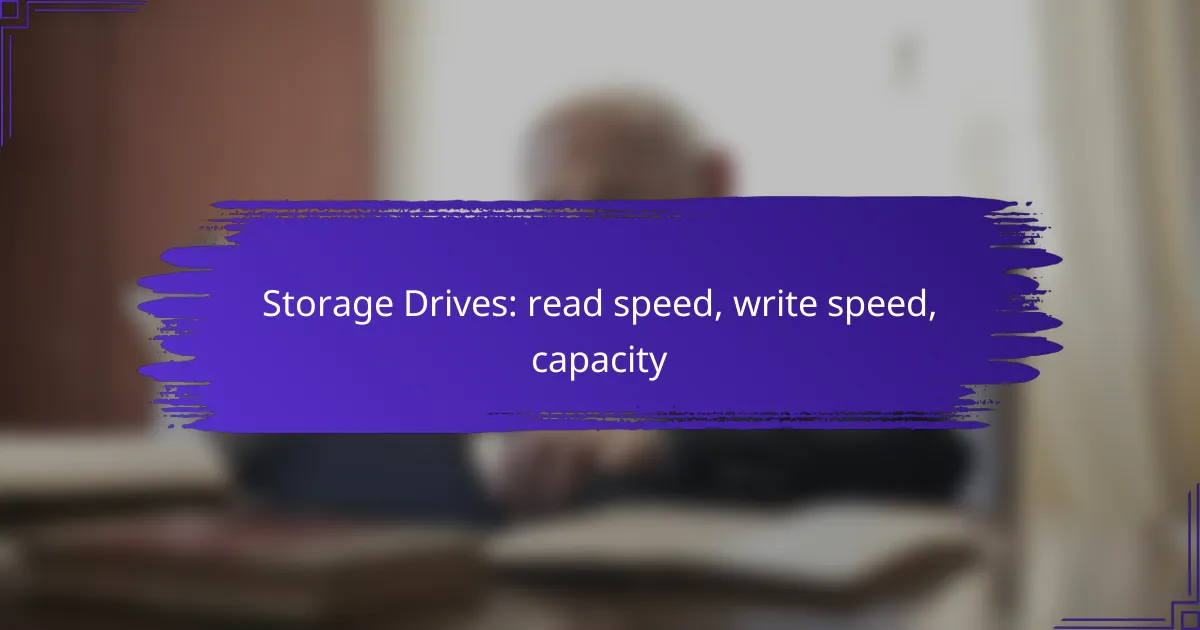Storage drives play a crucial role in determining the performance of your system, with read and write speeds being key factors. NVMe technology has revolutionized data transfer rates, making drives like the Samsung 970 EVO Plus and Western Digital Black SN850 top choices for speed. Additionally, higher capacity drives not only store more data but also enhance efficiency, leading to improved overall performance.

What are the best storage drives for read speed in the UK?
The best storage drives for read speed in the UK typically feature NVMe technology, which allows for significantly faster data transfer rates compared to traditional SATA drives. Key models to consider include the Samsung 970 EVO Plus, Western Digital Black SN850, and Crucial P5 Plus, each offering impressive performance for various use cases.
Samsung 970 EVO Plus
The Samsung 970 EVO Plus is renowned for its high read speeds, reaching up to 3,500 MB/s. This drive utilizes the NVMe interface, making it ideal for tasks requiring quick data access, such as gaming or video editing.
When selecting the 970 EVO Plus, consider its capacity options, which range from 250 GB to 2 TB. This flexibility allows users to choose a size that fits their storage needs without compromising on speed.
Western Digital Black SN850
The Western Digital Black SN850 offers exceptional read speeds, peaking at around 7,000 MB/s, making it one of the fastest consumer SSDs available. This drive is particularly suited for high-performance gaming and demanding applications.
It is available in capacities from 500 GB to 2 TB. Users should ensure their system supports PCIe 4.0 to fully utilize the drive’s capabilities, as older systems may not achieve these speeds.
Crucial P5 Plus
The Crucial P5 Plus provides competitive read speeds of up to 6,600 MB/s, making it a strong contender for users seeking high performance at a more affordable price point. Its NVMe interface ensures quick data retrieval for various applications.
With storage options ranging from 250 GB to 2 TB, the P5 Plus is versatile for different user needs. It is important to check compatibility with your motherboard to maximize performance, especially for those upgrading from older SATA drives.
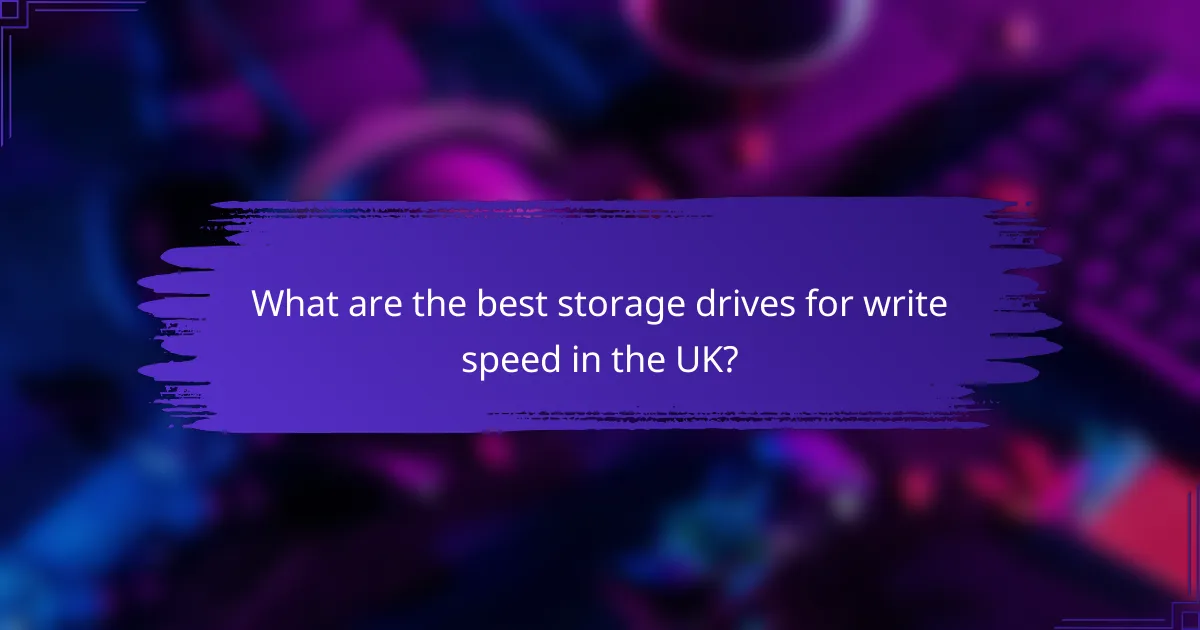
What are the best storage drives for write speed in the UK?
The best storage drives for write speed in the UK typically include high-performance SSDs that excel in data transfer rates. Drives like the Samsung 980 PRO, Seagate FireCuda 530, and ADATA XPG Gammix S70 are among the top choices, offering impressive write speeds suitable for demanding applications.
Samsung 980 PRO
The Samsung 980 PRO is a leading NVMe SSD known for its exceptional write speeds, reaching up to 5,000 MB/s. This drive utilizes PCIe 4.0 technology, which allows for faster data transfer compared to older standards.
When considering the Samsung 980 PRO, it’s important to evaluate your system’s compatibility with PCIe 4.0 to fully leverage its capabilities. This drive is ideal for gamers and content creators who require quick file transfers and efficient performance.
Seagate FireCuda 530
The Seagate FireCuda 530 is another top contender, boasting write speeds of up to 7,300 MB/s, making it one of the fastest SSDs available. It is designed for high-performance gaming and intensive workloads, ensuring minimal lag during data-heavy tasks.
For users in the UK, the FireCuda 530 is a great option if you need a reliable drive for gaming or video editing. Its durability and speed make it a worthwhile investment, especially for those who prioritize performance.
ADATA XPG Gammix S70
The ADATA XPG Gammix S70 offers impressive write speeds of up to 7,400 MB/s, positioning it as a strong competitor in the high-speed SSD market. This drive is built with advanced thermal management features, which help maintain performance during extended use.
When selecting the ADATA XPG Gammix S70, consider its suitability for high-demand applications like 4K gaming or large file transfers. Its combination of speed and thermal efficiency makes it a solid choice for users looking to enhance their system’s performance in the UK.
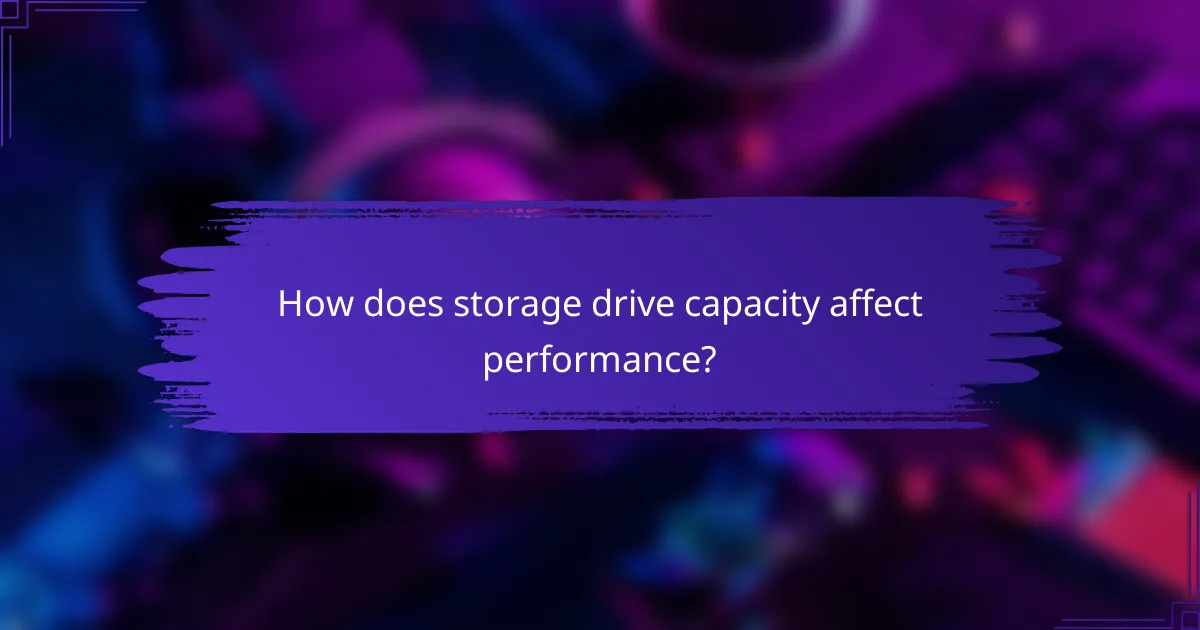
How does storage drive capacity affect performance?
Storage drive capacity significantly influences performance, particularly in terms of speed and efficiency. Generally, higher capacity drives can manage data more effectively, leading to improved read and write speeds.
Higher capacity drives offer better performance
Drives with larger capacities tend to perform better because they have more space to distribute data. This distribution reduces the time it takes to access files, as the drive can read from multiple locations simultaneously. For instance, a 2TB drive may outperform a 500GB drive in data-intensive tasks like video editing or gaming.
Moreover, larger drives often utilize advanced technologies that enhance performance, such as multi-layer NAND flash in SSDs. These technologies can lead to faster data retrieval and improved overall responsiveness.
Impact of capacity on read/write speeds
The read and write speeds of storage drives are closely tied to their capacity. Typically, as capacity increases, so do the read/write speeds, especially in solid-state drives (SSDs). For example, a drive with 1TB capacity may offer read speeds ranging from 500 MB/s to over 3,000 MB/s, depending on the technology used.
However, it’s essential to consider that not all high-capacity drives perform equally. Factors such as the drive’s interface (SATA vs. NVMe) and the type of NAND used can significantly affect speed. Always check the specifications to ensure you are getting the desired performance for your storage needs.
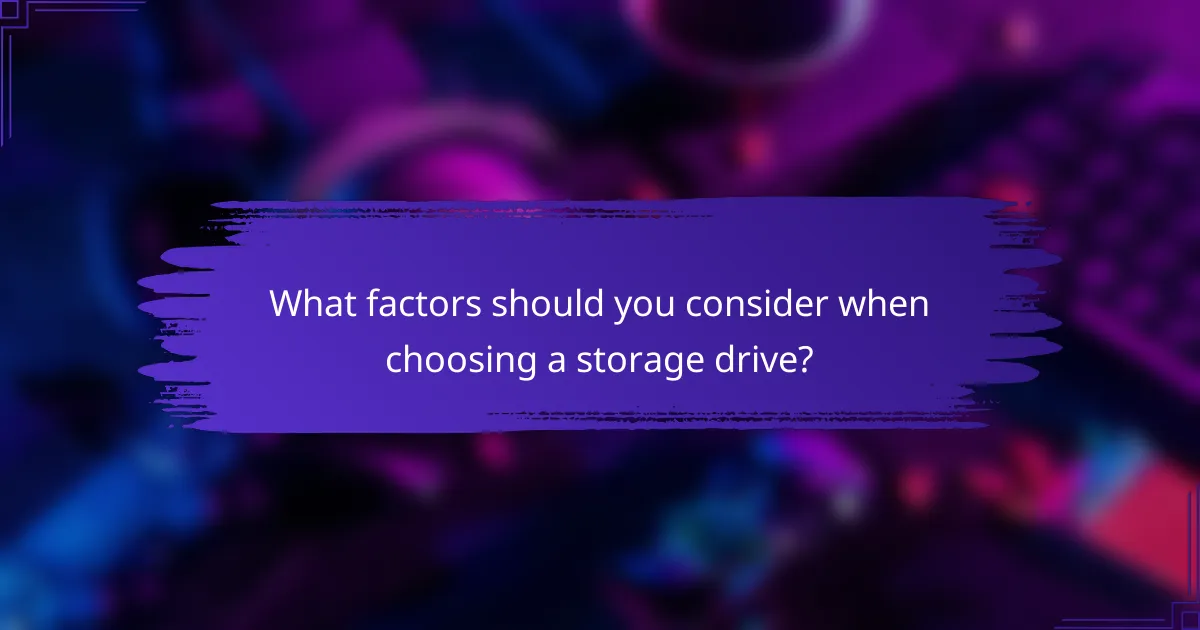
What factors should you consider when choosing a storage drive?
When selecting a storage drive, key factors include read speed, write speed, and capacity. These elements significantly impact the performance and usability of the drive for your specific needs.
Read speed
Read speed refers to how quickly data can be retrieved from a storage drive. This is crucial for tasks such as loading applications, accessing files, and streaming media. Generally, higher read speeds lead to better performance, especially for large files or when multitasking.
For example, solid-state drives (SSDs) typically offer read speeds ranging from hundreds to thousands of megabytes per second (MB/s), while traditional hard disk drives (HDDs) usually range from 80 to 160 MB/s. If you frequently work with large files or run demanding applications, prioritize drives with higher read speeds.
Write speed
Write speed indicates how fast data can be saved to a storage drive. This factor is essential for tasks like saving files, installing software, or backing up data. A higher write speed can significantly reduce the time needed for these operations.
Similar to read speeds, SSDs often provide write speeds from hundreds to thousands of MB/s, whereas HDDs generally fall within the 70 to 150 MB/s range. If you often create or modify large files, opt for a drive with superior write speeds to enhance your workflow.
Capacity
Capacity refers to the total amount of data a storage drive can hold, typically measured in gigabytes (GB) or terabytes (TB). Choosing the right capacity depends on your storage needs, such as the number of files, applications, and media you plan to store.
Common capacities for consumer drives range from 256 GB to several TB. For instance, a 1 TB drive can hold approximately 250,000 photos or 500 hours of HD video. Assess your current and future storage requirements to select a drive that offers sufficient capacity without overspending on unnecessary space.
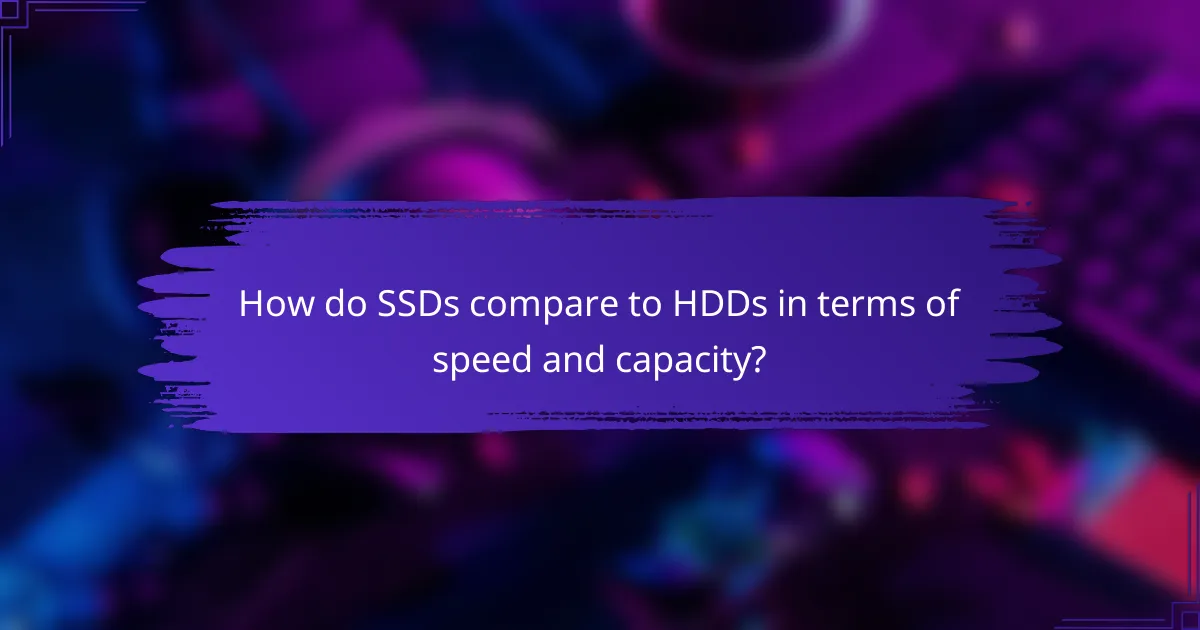
How do SSDs compare to HDDs in terms of speed and capacity?
SSDs (Solid State Drives) significantly outperform HDDs (Hard Disk Drives) in speed but typically offer less storage capacity for the price. While SSDs provide faster read and write speeds, HDDs are generally more cost-effective for larger storage needs.
SSDs have faster read/write speeds
SSDs utilize flash memory, allowing for rapid data access and transfer rates, often exceeding 500 MB/s for read and write operations. This speed is particularly beneficial for tasks requiring quick loading times, such as operating systems and applications.
In contrast, HDDs rely on mechanical parts, resulting in slower speeds, typically ranging from 80 to 160 MB/s. For users who prioritize performance, especially in gaming or video editing, SSDs are the superior choice.
HDDs offer larger capacities at lower prices
HDDs are available in larger capacities, often exceeding 10 TB, making them ideal for storing vast amounts of data, such as videos, photos, and backups. Prices for HDDs can be significantly lower, often around $20 to $30 per terabyte, compared to SSDs, which can cost several times more for the same capacity.
For budget-conscious users or those needing extensive storage without high-speed requirements, HDDs present a more economical solution. However, it’s essential to balance speed and capacity based on individual needs, as SSDs may still be worth the investment for their performance benefits.

What are the emerging trends in storage drive technology?
Emerging trends in storage drive technology focus on increasing speed, capacity, and efficiency. Innovations such as NVMe interfaces, 3D NAND technology, and the integration of AI for data management are reshaping the landscape of storage solutions.
Read Speed
Read speed refers to how quickly data can be accessed from a storage drive. Modern SSDs can achieve read speeds exceeding 5000 MB/s, significantly faster than traditional HDDs, which typically range from 80 to 160 MB/s. This speed is crucial for applications requiring quick data retrieval, such as gaming and video editing.
When selecting a storage drive, consider the read speed in relation to your usage needs. For general tasks, a read speed around 500 MB/s may suffice, while high-performance tasks benefit from SSDs with speeds above 3000 MB/s. Always check compatibility with your system’s interface, such as SATA or NVMe.
Write Speed
Write speed indicates how fast data can be saved to a storage drive. SSDs generally offer write speeds ranging from 300 MB/s to over 4000 MB/s, while HDDs usually fall between 70 and 150 MB/s. High write speeds are essential for tasks like video recording or large file transfers.
For optimal performance, choose a drive with a write speed that matches your workload. If you frequently handle large files or run applications that require rapid data saving, aim for SSDs with write speeds above 2000 MB/s. Be mindful of the drive’s endurance rating, as higher write speeds can affect longevity.
Capacity
Capacity refers to the amount of data a storage drive can hold, typically measured in gigabytes (GB) or terabytes (TB). Current consumer SSDs range from 250 GB to 8 TB, while HDDs can offer capacities up to 20 TB or more. Your choice should depend on your storage needs and budget.
When selecting a drive, consider how much data you plan to store. For everyday use, a 1 TB drive is often sufficient, while gamers or content creators may require 2 TB or more. Keep in mind that SSDs are generally more expensive per GB than HDDs, so balance your needs with your budget when making a decision.
